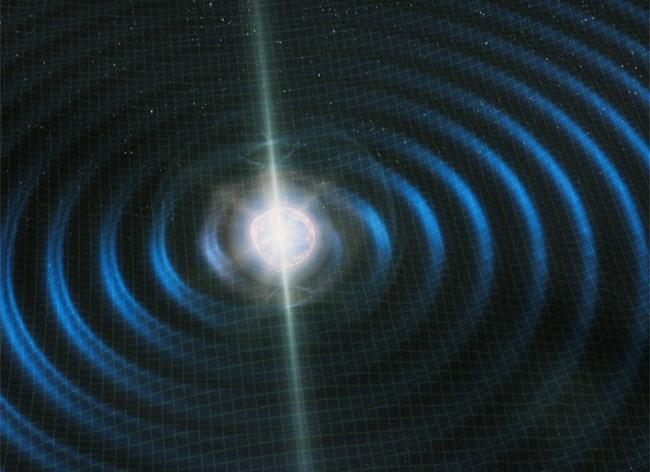Gravitational Waves
The newest branch of astronomy doesn’t rely on light. Instead, it measures gravitational waves: tiny ripples in the structure of spacetime created by colliding black holes, neutron stars, or other powerful cosmic events. Gravitational wave astronomy allows us to probe a new part of the unseen universe, with its own challenges and knowledge we can’t get other ways.
Our Work
Center for Astrophysics | Harvard & Smithsonian scientists study gravitational waves in several different ways:
-
Using visible light, X-ray, and radio telescopes to perform follow-up observations of gravitational wave events from LIGO. In particular, neutron star collisions produce a lot of light in addition to gravitational radiation. While the gravitational waves reveal details about the masses and shapes of the neutron stars, light tells us about the violent nuclear and chemical reactions, along with the material that is blown off during the explosion.
Astronomers See Light Show Associated With Gravitational Waves -
Working with the international LIGO collaboration to identify and characterize the astronomical systems involved in producing gravitational wave events. The data from gravitational waves are used to understand the nature of black holes, neutron stars, and even the evolution of the universe as a whole.
Gravitational Waves Measure the Universe - Identifying systems consisting of two white dwarfs locked in mutual orbit. LIGO isn’t sensitive to gravitational waves from these binaries, but they’ll be the most common source for the upcoming Laser Interferometer Space Antenna (LISA), a joint NASA-ESA space-based gravitational wave observatory. One of these binaries completes one orbit every 12.75 minutes, making it the “brightest” known gravitational wave source for LISA.
Space-Warping White Dwarfs Produce Gravitational Waves

This artist's impression shows the final stage of the merger of two neutron stars and the gravitational waves produced by the collision. Astronomers identified such a merger in 2017 using gravitational wave detectors, as well as with optical and X-ray telescopes.
Astronomy Using Gravity
Gravitational waves, also known as gravitational radiation, were predicted by Albert Einstein as a consequence of his theory of general relativity. This theory describes gravity as distortions in the structure of spacetime created by matter and energy. Einstein realized those distortions would travel at the speed of light in the form of waves, much like light itself can be described as a wave.
However, gravity is so weak that even a high-energy gravitational wave barely nudges objects in its path. For that reason, our best hope is to detect gravitational waves from objects that produce very intense gravity because they pack a lot of mass into a very small space. That category includes the sources we’ve detected so far: colliding black holes and neutron stars.
In 2015, a century after Einstein published general relativity, researchers used the Laser Interferometer Gravitational Observatory (LIGO) to detect the collision between two black holes. Two years later, LIGO scientists identified a collision between two neutron stars, an event also observed using light.
Using both gravitational wave and light-based astronomy is known as “multimessenger astronomy”. This is an exciting development for researchers studying the structure of neutron stars, and understanding the creation of many chemical elements such as gold, which are produced in neutron star collisions.
Related News
Giant Magellan Telescope Mount Fabrication Begins
CfA Celebrates 25 Years with the Chandra X-ray Observatory
The Giant Magellan Telescope’s Final Mirror Fabrication Begins
Streamlining the Search for Black Holes
Tracing the Origins of Rare, Cosmic Explosions
CfA Scientists Awarded Prestigious NASA Hubble Fellowships
The Unfolding Story of a Kilonova Told in X-rays
Projects
AstroAI
GMACS
For Scientists
Sensing the Dynamic Universe
SDU Website
Telescopes and Instruments
Giant Magellan Telescope
Visit the GMT Website
Magellan Telescopes
Visit the Magellan Telescopes Website
MMT Observatory
Visit the MMT Website